For many people, the concept of solar energy brings images of hundreds of photovoltaic (PV) panels spread out on rooftops or occupying large community fields.
There are other interesting technologies in this field that don’t get the hype despite having considerable potential. One of these is concentrated solar power (CSP).
CSP fields are typified by thousands of mirrors with a tower in the center that generates electricity.
To understand CSP, let’s dig a little deeper to discover how it works and explore the pros and cons of this type of solar energy harvesting.
Define Concentrated Solar Power
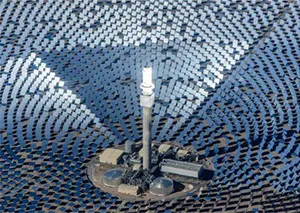
Concentrated solar power is electricity produced by mirrors that direct the sun’s rays to a central tower. Water in the generator is heated to produce steam that spins a generator turbine to produce electricity.
In This Article:
- Define Concentrated Solar Power
- What is Concentrated Solar Power?
- 4 Types of Concentrated Solar Power Systems
- Top Concentrated Solar Power Plants
- Concentrated Solar Power Efficiency
- Concentrated Solar Power Advantages and Disadvantages
- Concentrated Solar Power Advantages
- Concentrated Solar Power Disadvantages
- Environmental Impact of Concentrated Solar Power
- Concentrated Solar Bird Deaths
- Difference Between Concentrated Solar and Photovoltaics
- Final Thoughts
What is Concentrated Solar Power?
Concentrated solar is a bit more like traditional electricity generation in that it doesn’t convert the solar energy directly into electricity as solar panels do. Here’s how concentrated solar works.
- Concentrated solar uses mirrors to reflect and concentrate solar energy on a specific point (receiver).
- During the process, the solar energy from the sunlight is converted to thermal energy (heat).
- The heat is transferred into a working liquid. This is sometimes synthetic oil and sometimes molten salt.
- The hot oil or salt travels through a sealed heat exchanger, heating water to boiling.
- Steam from the boiling water spins a turbine to generate electricity.
When molten salt or another thick substrate is used for heat transfer, the power generation can go longer, because there is so much heat stored in the molten salt.
This is a big advantage that this type of solar generator has over regular photovoltaic panels.
4 Types of Concentrated Solar Power Systems

There are four approaches to concentrated solar technology.
- Parabolic trough
- Parabolic dish
- Power tower
- Linear fresnel systems
Let’s take a look at each one to see how it works to generate electricity.
Parabolic Trough

These systems use large curved mirrors to focus solar energy onto a receiver tube running down the center of a trough. Within the tube is a high-temperature heat transfer fluid like synthetic oil.
The oil absorbs the sun’s heat energy and is heated to temperatures higher than 750 degrees Fahrenheit.
The oil or working fluid passes through a closed heat exchanger, where it heats water to produce steam. This steam is used to spin a turbine to generate electricity.
In a parabolic trough system field, the mirrors are arranged in hundreds of parallel rows on a north-south axis so they can track the sun from east to west.
Power Tower
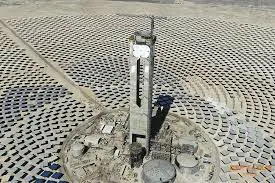
This system uses computer-controlled mirrors (heliostats) to track the sun’s movement and focus solar energy on a receiver at the top of a tower.
The concentrated thermal energy then heats a transfer fluid to temperatures over 1,000 degrees Fahrenheit, used to produce steam. The steam spins a generator turbine to make electricity.
Molten salt is the thermal fluid typically used in power tower systems. Molten salt is a salt mixture that is solid at normal temperatures but becomes molten at very high temperatures.
Because molten salt retains heat efficiently, it can be used to make steam immediately or stored for later use. This allows for peak electricity generation on cloudy days or even a few hours after sunset.
Linear Fresnel Systems
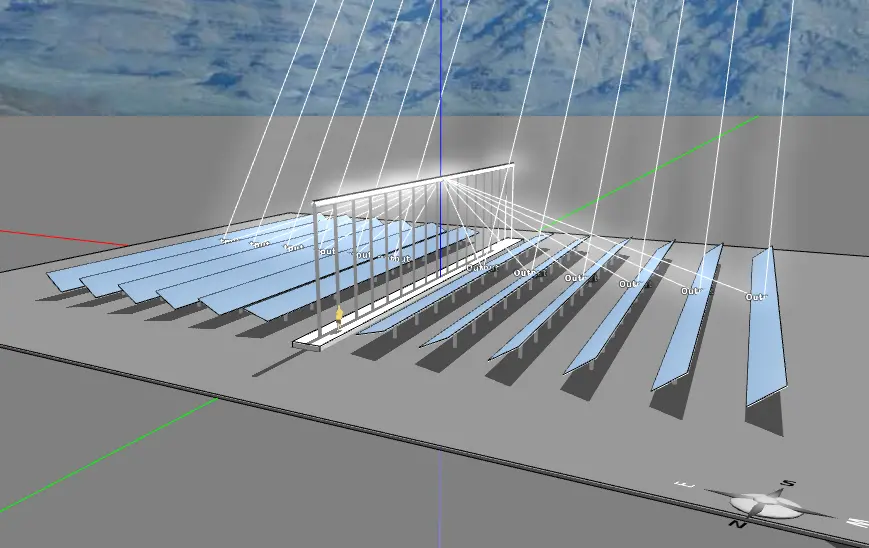
Commonly referred to as Compact Linear Fresnel Reflectors (CFNL), these systems are similar to parabolic troughs. However, they use long parallel rows of flat mirrors in place of curved mirrors.
These mirrors focus sunlight onto an elevated receiver with a system of tubes flowing with water.
The concentrated solar energy boils the water producing high-pressure steam that spins a steam generator turbine to produce electricity.
Parabolic Dish Systems

These solar concentrators use mirrored dishes to concentrate sunlight onto a receiver mounted at the focal point. Each dish resembles a backyard satellite dish, only larger.
It can rotate along two axes and uses a tracking system to follow the sun.
Unlike other concentrated solar technologies that use steam turbines, the receiver in parabolic dishes is integrated into a combustion engine.
The engine has thin tubes with a working fluid, like hydrogen, heated to temperatures as high as 1,200 degrees Fahrenheit. This heat causes the gas to expand and drive pistons that turn a crankshaft to generate electricity.
Top Concentrated Solar Power Plants
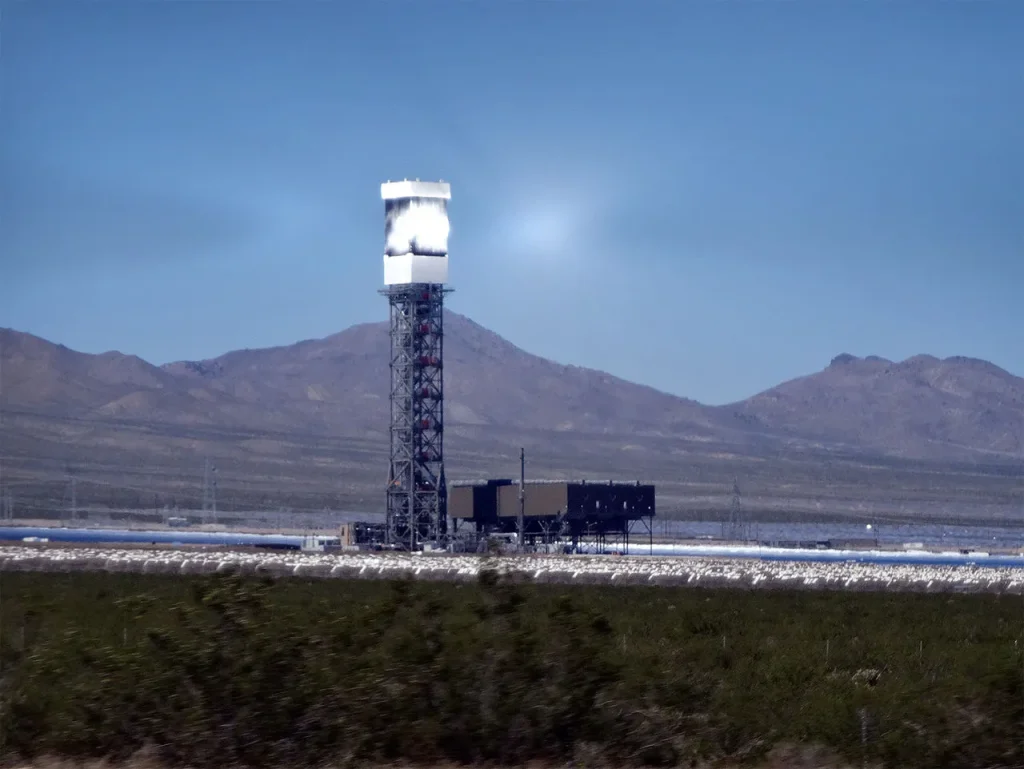
Concentrated solar power plants can be found on almost every continent.
However, most of the world’s installations sit in Spain, accounting for around 42% of all CSP projects.
With a capacity of 510 MW, enough to provide power to 1.1 million people, Morocco’s Ouarzazate Solar Power Station is the largest CSP project in the world.
Today, the United States has 52 concentrating solar power plants. The largest of these is the Ivanpah Solar Electric Generating System in California’s Mojave desert, with a capacity of 392MW.
Other large-scale CSP projects include:
- Mojave Solar One in Los Angeles
- Solana power plant near Gila Bend, Arizona
- The Crescent Dunes project in Tonopah Nevada – decommissioned due to a molten salt leak
- Genesis Solar in Blythe, California
- Nevada Solar One, Boulder City, Nevada
- Kimberlina Solar Thermal Power Plant in California
- Sierra Sun Tower in Lancaster, California
- Martin Next Generation Solar Energy Center in Florida
- Stillwater Solar Geothermal Hybrid Project in Nevada
There haven’t been any new concentrating solar power projects in the country since 2016.
This is probably because CSP is only feasible in large-scale power plants, and establishing one is easier said than done.
Furthermore, there are a higher number of CSP plants falling into disrepair or being decommissioned because of the massive scale of the project.
It’s easy to get funding to install one, but hard to fund the maintenance, and power companies may not see enough monetary gain from them to keep them in repair instead of abandoning the project.
Check out this video to get the scoop on the ups and downs of the CSP plant in Tonopah, Nevada.
Nevertheless, the SEIA lays out the following requirements for a viable CTP project.
Financing
Being a utility-scale energy-generating facility, establishing a CSP plant is a relatively expensive affair.
There are a couple of reasons for this, the chief being that current CSP technologies are still regarded as somewhat experimental. With experimental technology comes high investment costs.
Fortunately, CSP is following the same trend as PV technology – it’s getting cheaper.
As of 2020, the cost per kilowatt installed was 4,725 U.S dollars. This is a pretty comfortable 50% drop from the 10,588 dollars it cost to install the same amount in 2011.
Large Parcels of Land
True to the nature of utility-scale projects, concentrating solar power also demands large areas of land. This is because they are most efficient and cost-effective when built in sizes of at least 100MW.
The SEIA estimates that the average CSP plant requires 5 to 10 acres of land per MW. That’s a lot of space for not a lot of output.
High Solar Radiation
Concentrated solar power requires as much solar radiation as it does space. The sun’s energy must not be too diffused or the project will waste financial resources and valuable real estate.
Thus, renewable energy experts use sunlight’s direct normal intensity (DNI) to determine the CSP viability of an area. And as you would expect, the US Southwest stands out as the region with the most potential.
Access to Water Resources
Due to its reliance on thermal energy to produce electricity, CSP systems require a lot of water for cooling. Although other techniques are being tried, water cooling remains the primary way to cool CSP components.
Water is also required for steam generation to spin the generator turbines.
This presents serious challenges because the prime areas for solar concentrator installations are also ones that face serious water shortages.
Convenient Transmission Access
Concentrated solar plants must also be sited near a transmission grid, preferably one that’s outdated and stressed by the current energy demands.
This siting of a CSP plant in areas where new transmission is urgently needed creates a ready market for the electrical energy produced. This means that top dollar can be earned per kilowatt.
The Southwest U.S also stands as an ideal candidate under these conditions.
Concentrated Solar Power Efficiency

The energy efficiency of CSP systems ranges between 7% and 25%, depending on the type of system, engine, and receiver.
Compared to other renewables like hydropower, wind turbines, and solar PV cells with efficiencies of 90%, 59%, and 23%, respectively, CSP is not the most efficient energy source.
However, more research leading to innovation and better technologies could see the efficiency of concentrated solar rise.
Concentrated Solar Power Advantages and Disadvantages
| Pros of Concentrated Solar | Cons of Concentrated Solar |
| Uses renewable energy source | Expensive to build |
| Doesn’t emit carbon dioxide | Requires a lot of land |
| Simpler to maintain | Requires fresh water |
| Heat can be stored for later use | Does rely on natural gas in some instances |
| Can be paired with existing power plants |
Concentrated Solar Power Advantages
There are a lot of advantages to concentrated solar which is why many energy companies have invested in this technology. Do the pros outweigh the cons? Usually they do, but not always.
- The biggest advantage of CSP lies in the use of renewable energy. It uses the sun’s energy to generate heat, and we can never exhaust the sun’s heat.
- Concentrated solar power doesn’t emit carbon dioxide while it’s running on solar alone. Some of the plants also rely on natural gas, but we’ll discuss that aspect in the disadvantages of concentrated solar.
- Operating and maintaining CSP plants is also much simpler than maintaining nuclear or hydrocarbon-based plants. This makes the operating costs of concentrated solar power cheaper than these sources.
- CSP provides a more continuous source of electricity compared to PV solar and wind. This is especially the case with plants that use molten salt as the thermal fluid because molten salt can store energy for later use.
CSP systems can be integrated into existing steam-based power plants, like those running on fossil fuels. This type of hybrid system saves fossil fuel consumption.
Concentrated Solar Power Disadvantages
There are quite a few disadvantages that have even resulted in decommissioning or abandonment of several CSP installations.
It’s a shame because the investment was wasted and now the materials have been left to decay and contaminate the desert environment.
Here are some of the disadvantages of concentrated solar power systems.
- CSP is very expensive to set up and run. This is because it requires special materials like molten salt, which is difficult to obtain and costly to source.
- CSP requires a lot of acreage to operate, making it highly unsuitable for populated areas. There is also the question of the opportunity cost of the land being used to establish concentrated solar plants.
- CSP plants use freshwater resources that are scarce in areas they choose to for concentrated solar installations.
- CSP plants may not emit greenhouse gases when they’re operating only on solar power, but those like Ivanpah also burn natural gas – a greenhouse gas producer.
Many people think that because most CSP installations are in the desert Southwest that the land is useless anyway so it might as well be covered with massive mirrors. This is not so.
The land and resources are precious to the birds, animals, reptiles, and people who call the desert home. These installations are disruptive eyesores and it’s heartbreaking to see them left to decay on the land.
Environmental Impact of Concentrated Solar Power
CSP also carries environmental impacts that can’t quite be ignored. Solar energy provided by photovoltaics doesn’t have these concerns.
For instance, power plants need a lot of water for cooling and power generation but they are often situated in arid areas where access to freshwater is scarce.
This has raised angered many residents and skeptics, especially in places like the American Southwest, Middle East, and North Africa, where the demand for limited freshwater is on the rise.
CSP plants are sometimes set up on lands with environmental value. Such lands are home to endangered flora and fauna species, often killed or forced to migrate by the sudden change in their natural habitat.
Concentrating Solar Plants Burn Natural Gas
Plants like Ivanpah still burn natural gas at the plant. They burn it in the morning to get the concentrator hot and burn more whenever the sun is not strong enough to keep the generator producing power.
In its first year, Ivanpah released 46,000 tons of carbon dioxide into the atmosphere. That amount has only been increasing.
They frequently petition the California Energy Commission to increase their use of natural gas. So their greenhouse gas emissions increase despite the subsidies they receive for being “green” energy.
To be fair, the carbons released even by a “dirty” solar plant like Ivanpah is a fraction of those released by traditional fossil fuel energy plants. We view it as more of a hybrid energy plant than truly green energy.
When you consider the local environmental issues faced by areas served by concentrated solar power plants, the diminished greenhouse gas pollution from CSP is still a step in the right direction.
Concentrated Solar Bird Deaths

It’s true. Every concentrated solar installation is killing thousands of birds every year.
Just at the Ivanpah CSP alone, over 6,000 birds die yearly, instantly incinerated by the intense heat in the concentrated solar beams. The birds fly into the solar field hunting bugs or during migration.
Environmental groups are very concerned about the toll that these plants have on the living creatures in these areas. It’s an intensely dangerous machine that’s been set up in the natural habitat.
Though people don’t value the land around Ivanpah, it’s directly on the Pacific Flyway – the migration route for many birds, including many protected and endangered species.
They’re not being protected from incineration during their natural migration.
Earthbound birds are dying too. Roadrunners are being killed in record numbers by coyotes as they get stuck outside the fence that protects endangered desert tortoises from wandering into the solar field.
The pros and cons of solar energy provided by solar panels do not include these huge risks to wildlife.
Difference Between Concentrated Solar and Photovoltaics
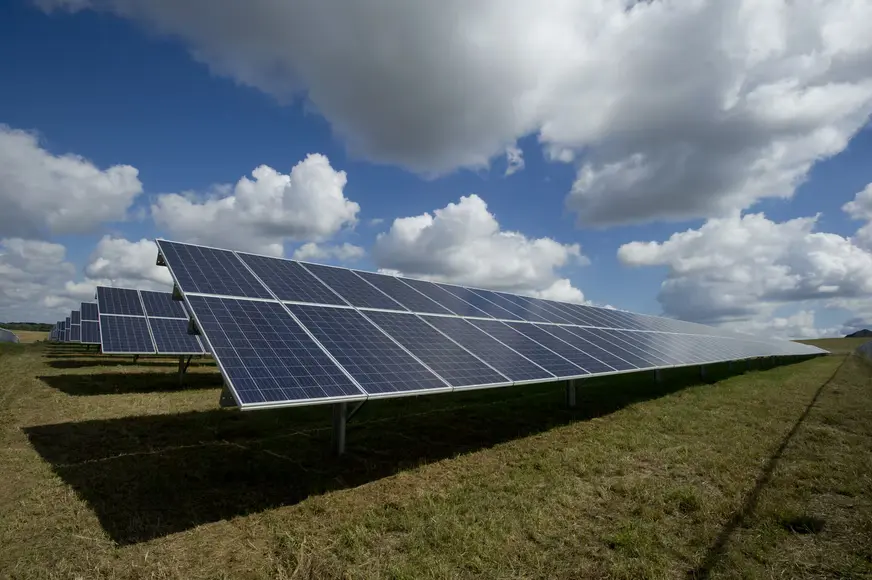
The difference between concentrated solar (CSP) and photovoltaics is in how the energy is generated.
Photovoltaics use electrons to directly convert solar energy into electricity. CSP uses solar energy to power steam turbines.
| Concentrated Solar | Photovoltaics | |
| Panel Material | Mirrors (flat or parabolic) | Multilayered silicon panels that create electron imbalances in the presence of solar radiation |
| Mode of Operation | Concentration and reflection of the sun’s rays onto a concentrator receiver | Direct generation of electricity by conversion of solar radiation into electrical impulses |
| Output | Steam spins a generator turbine to create electricity | DC current that must be converted to AC current |
| Efficiency | 7% to 25% efficiency | 15%-20% efficiency (some reach 35%) |
| Scalability | Not very scalable. The smallest CSP units are the size of a huge satellite dish. | Ultimately scalable from tiny solar dots to solar farms in space. |
It’s easy to see that while both types of technology use the sun’s energy to produce electricity, they do it in very different ways.
On one hand, CSP seems like it would be less pollutive than PV panels because there aren’t so many rare elements needed to produce mirrors.
However, the output isn’t comparable to the natural resources required to manufacture and install. The output versus manufacturing input of PV panels is much better, making it the ultimate long-term winner.
Final Thoughts
Concentrating solar power is not the cheapest nor most efficient renewable energy source.
It’s safe to say that it is significantly lagging behind PV, wind energy, and nuclear power in terms of technological development and adoption.
But due to efforts from large-scale utilities and the National Renewable Energy Laboratory, it remains a decent and promising renewable energy source.
Even though the popularity of CSP is waning in the United States, it’s becoming a more widespread source of power in other areas of the world.
What are your thoughts about CSP? Do you live near a CSP installation? Let us know in the comments below!

